
Is e-Commerce sustainable?
I used to be convinced that e-Commerce is a bad thing for the planet: with the emission from the delivery and the electricity usage, I felt guilty to sit in my sofa and order things that would magically be in my apartment without having to move anything other than my thumb on the screen. I had to think again. Here is why.
Online commerce is growing fast and already represents a significant part of the retail market ,14% in France in 2021, and more than 25% in China.
According to the latest ADEME* report dating from April 2023, more than 80% of the French population shop online, so we really need to ask ourselves the question: is this good news for the climate?
This article aims to understand the ins and outs of this complex topic.

Gregoire Lepault
Associate –Head of Technology & Data
What is the impact of Product Distribution?
Before talking about distribution, it is important to take a step back and acknowledge that each step of the value chain for consumer goods emit greenhouse gases (GHG).
When comparing products, the relative emissions can vary a lot from one step of the value chain to another. For example, a gas stove or a gasoline car has the biggest share of emissions during the usage phase, amounting to around 80% of the total GHG emissions. Meanwhile, about 80% of a TV’s emissions are due to the materials used to manufacture it, as pictured in the image below [1].
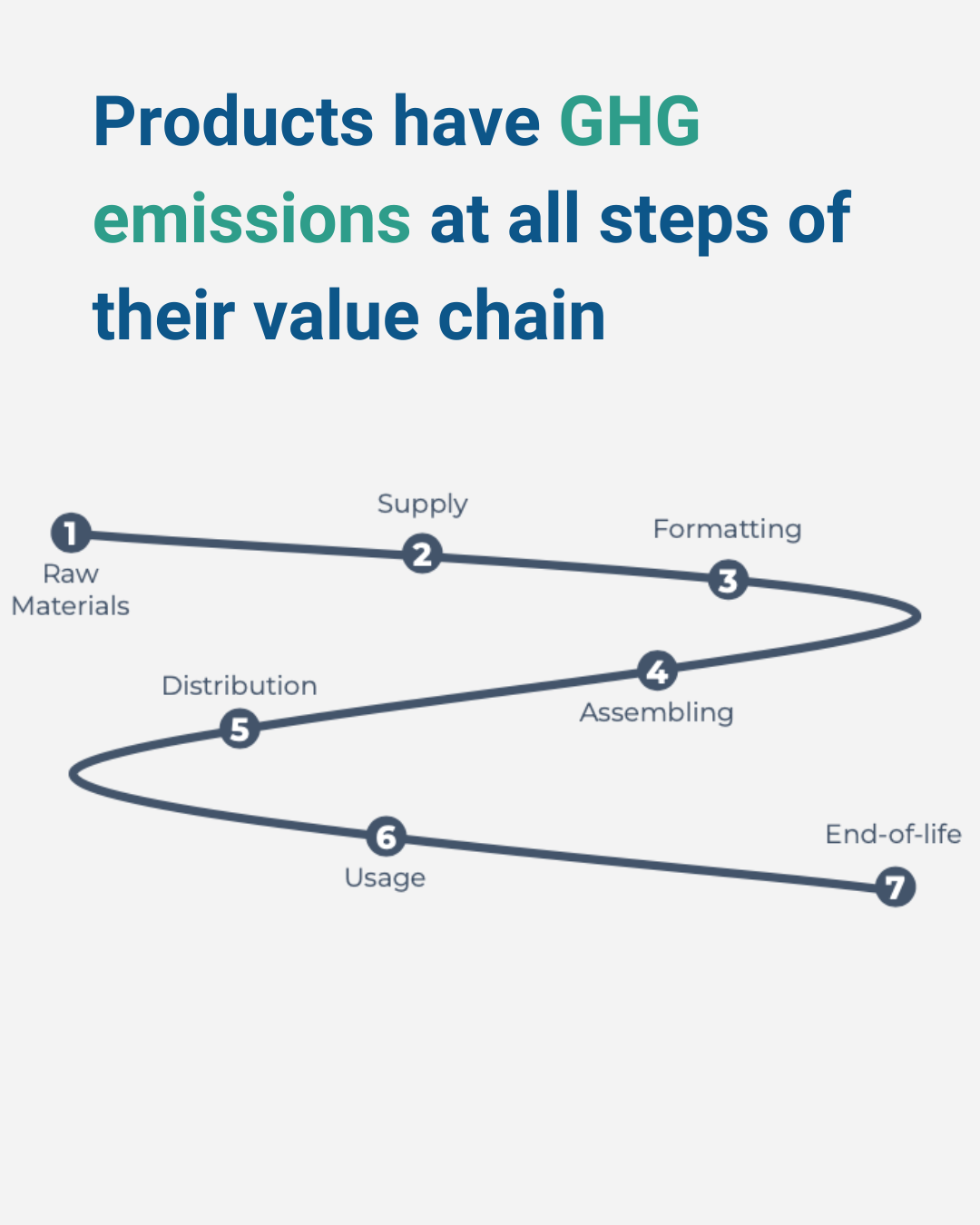

In absolute value, those emissions can also be very different from one product to another. For example, a book will emit on average 1kg of CO2e whereas a television will emit around 400kg of CO2e [2].
And what about distribution? As you can see in the previous image, GHG emissions associated with distribution can also differ from one product to another, from around 3 to 30% of the total impact of the product. A reasonable assumption is to consider that distribution will be, on average, 10% of the total product impact.
Distribution is indeed an important part to take into consideration for optimization, but the impact of the product itself cannot be ignored. Thus, the goal for manufacturers should still be to reduce the product’s overall impact. As a consumer, the best way to reduce a product’s impact is to not buy this product. This has been demonstrated magistrally by Paul Hawen in The Ecology of Commerce in 1993 [3]: “all the recycling in the world could not change the fact that doing business today is an energy-intensive endeavor that gulps down resources”. We have come a long way since then, but it is still true from a consumer standpoint: the only sustainable product, is the one you don’t buy. Like Patagonia put it in a famous adversting in the New York Time in 2011 on Black Friday:

Photo credits: Patagonia website, https://www.patagonia.com/stories/dont-buy-this-jacket-black-friday-and-the-new-york-times/story-18615.html
What is the best way to buy a product?
In asking this question our goal is not to provide a definite answer but to provide more insights on how to make the best decision.
To assess the environmental impact of e-commerce we analyzed the study by Oliver Wyman [3], where they compared the purchase of an average non-food product in both online and physical retail spaces. The conclusion is that on average, e-commerce emits about two times less GHGs than physical retail stores (for the distribution stage of the value chain).
The best way is still not to buy, but if a product really is needed, the question is: How should you buy it?
To assess the environmental impact of e-commerce, we analyzed the study by Oliver Wyman [4], where they compared the purchase of an average non-food product in both online and physical retail spaces. The conclusion is that on average, e-commerce emits about two times less GHGs than physical retail stores, focusing on the distribution stage of the value chain.
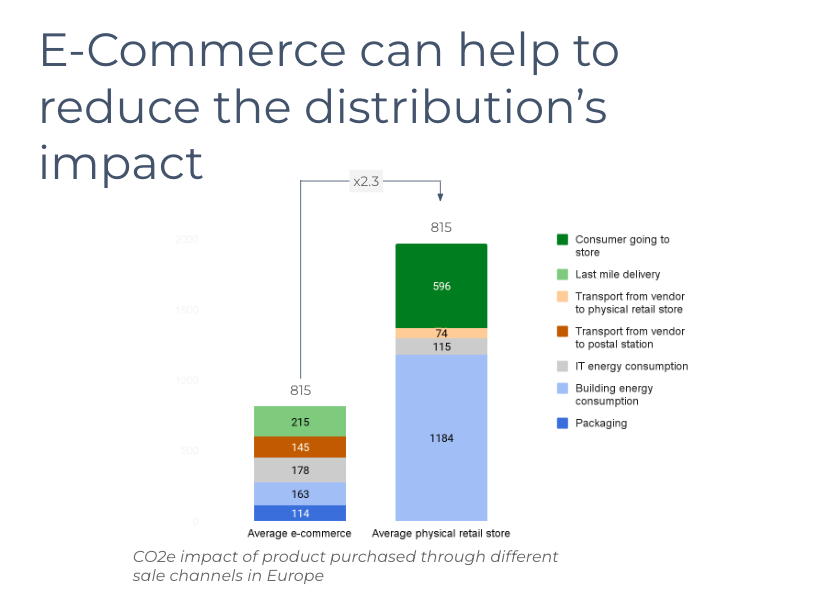
It is very interesting to highlight that the main sources of emissions are very different for the two scenarios:
- For physical retail, two main sources are responsible for 90% of the total emissions of distribution:
- Building Energy Consumption, mainly due to the heating of very large stores to welcome customers;
- Consumers Transportation, with around 55% of consumers going to a store using a car [3].
- For e-commerce, it is distributed between:
- Last Mile Delivery, associated with lower emissions than individual consumers’ transportation because the deliveries are grouped and optimized, for economical reasons of course, but still;
- Warehouse Energy Consumption, associated with a lot less GHG emissions due to increased density in storage, improved space utilization, and no material or energy intense in-store merchandising (screens, lights, podiums, temporary fancy shelves, etc..) when compared to physical stores;
- IT energy consumption, only slightly more GHG emissions in e-commerce when compared to retail since most physical stores also have a website;
- Packaging, a new source of emissions due to online shopping since over-packages are added to the product itself;
- Transport from the vendor to the postal station, also associated with higher GHG emissions since it is common to use air freight to speed up deliveries.
Once we understood that 90% of retail store’s impact is driven by the store energy consumption and consumer transportation, it is important to highlight that it will depend a lot on the location of the store and how the consumers are going to the store.
For example, in Germany, the electricity is more than 5x more carbon intensive than in France, the heating of a store in Germany will emit more GHG and thus, the difference between the impact of online shopping and e-commerce will be bigger. That is why, even if the consumer walks into the store, physical retail in Germany is still emitting more GHG than online shopping [4]. In France, that is not the case, when the consumer walks to the store the associated emissions are at least 2x smaller when compared to online shopping.
To put it simply, when looking at the breakdown above: In Germany, even if you let the SUV sit in the garage and bike to the shop, your impact will still be higher than if you order online.
Is Omnichannel the right solution?
Omni-channel could be a solution to reduce the distribution impact by proposing both stores and online shopping. In order to be efficient, an omni-channel player must be able to guide the consumer into the most virtuous distribution based on personal constraints. The ADEME has recently made a proposal in this direction, promoting guidance for consumers when purchasing a product online, based on their personal situation (location, distance to store, way of transportation…). The goal is to point out the best purchasing solution, between going to the physical store, using a relay point, or delivery (home or even work).
The drawback of omni-channel, if not done properly, is to add the emissions due to physical stores on top of online distribution emissions.
What can be done to reduce direct Distribution emissions?
As you can see, there is no one single correct answer when dealing with the question “e-commerce VS physical retail”, but there are many ways to reduce the impact.
As a physical retailer, the first thing is to build more sustainable buildings or renovate existing ones to reduce their energy consumption. Then the next step is to tackle consumers’ way of transportation by promoting soft means of travel such as walking, biking, and collective public transportation. It means creating shops closer to consumers, and more connected with public transportation.
As an e-commerce player, it is also important to improve building efficiency, electrify the fleet of delivery vehicles, propose slow delivery options to regroup orders and to have local storage facilities to avoid long-distance air freight.
As a consumer, several actions can have an impact to reduce the distribution of GHG emissions:
- Make sure you really need the product you want to purchase, and that the quality will make it last as long as possible;
- Use a low-carbon mode of transportation when going to a physical retail;
- Bulk purchasing and strategize commuting;
- Avoid returns
- Look for second-hand or refurbished versions of your product
E-Commerce as Sustainable Retail Lab – enabler of important Sustainability use cases
In addition to its impact on direct emissions, e-commerce could be an enabler to implement important Sustainability use cases on the entire product lifecycle, with four main pillars:
- Green Merchandising: Helping the consumer choose the product adapted to its needs with detailed environmental labelling and promotion of greener products to help transition turnover (and profits) from traditional products to the ones that have been improved;
- Omnichannel Intelligence: Reducing distribution impact by selecting, for example, the best distribution channel based on client characteristics through omnichannel intelligence;
- Consumer Engagement: Engaging consumers with training on how to best use products to reduce the impact of products’ usage, until the end of life. Build incentive that encourage long term loyalty, not only based on Recency / Frequency models, but long term engagement, advocacy & sustainable products purchase.
- Product Lifetime increase: Offer solutions to re-commerce, re-purpose, or re-cycle to guarantee the extension of the product lifetime (enabling different sequencial ownerships) or the circularity of materials at the end of life.
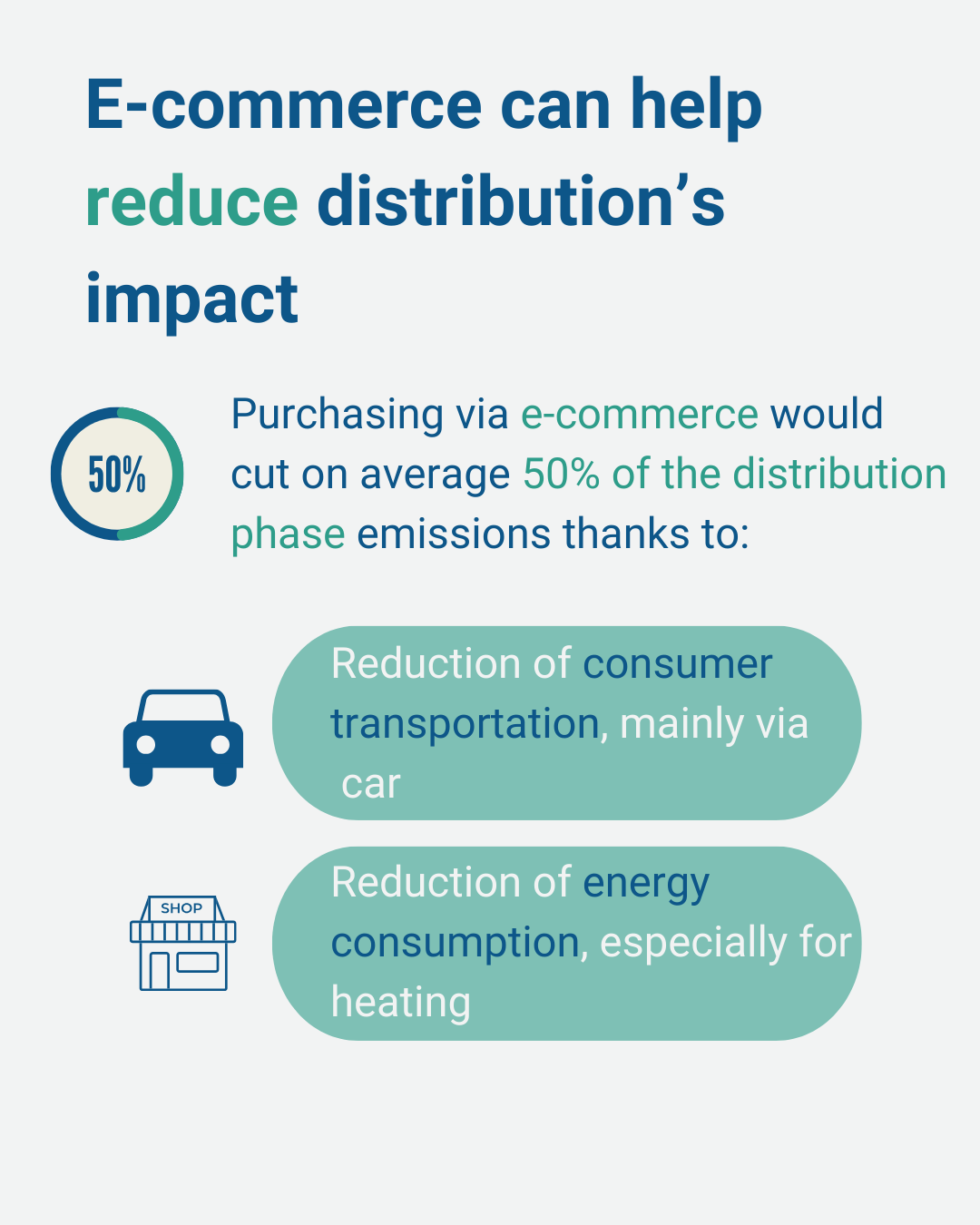
Sustainable E-Commerce Toolkit to get you started
This is easier said than done, and implementing such good practices to create an e-commerce more sustainable is a challenge that still need to be tackled. As we have seen, the biggest opportunity is to use Ecommerce and Digital channels as a Lab to define the Sustainable Retail of tomorrow, finding & testing news ways to transition consumption from “grey” to “greener” products, reinventing many of the Retail practices, from Retail Design and Merchandising to Loyalty program design.
To allow this process, we have co-developped with With Digital Agency a “Toolkit” with numerous concrete exemples from past Clients & international Best Practices (from Western countries but also Asia) to help Brands start this journey strategically & progressively.
Please reach out to us if you want to know more & receive the content: contact@impactlabs.earth
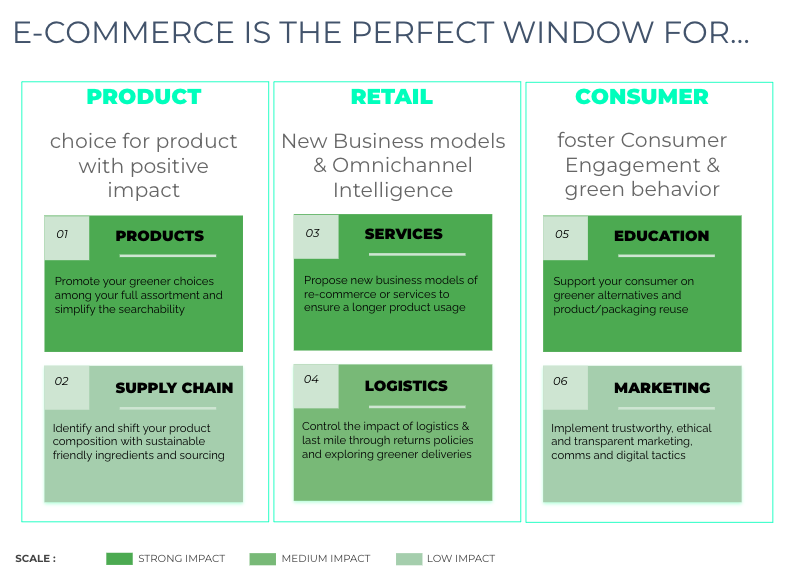
Conclusion
On average, online shopping reduces the impact of product distribution thanks to more optimized deliveries and less building energy consumption. This comparison will vary depending on the electricity carbon intensity of the store’s location and the consumer’s transportation.
But what is important to remember is that distribution is only 10% of the total GHG emissions and the best way to reduce the GHG is still to not purchase.
This is why e-commerce is often seen as the antithesis of sustainability because it has, most of the time, not replaced a usage but rather created new ones. This is also why e-commerce, beyond the distribution stage, should put more effort into giving the consumer information regarding the environmental impact of the product and also to promote low-carbon alternatives.
The objective of this article is to give a data-driven and fact based analysis on the impact of e-Commerce on climate change. Of course, with the acceleration of e-commerce, a lot of questions related to its social impact should be considered too. Is e-commerce destroying jobs? What about the local social interaction with small shops?
Our take on this: e-commerce is going to reach a stabilization plateau where local commerces and online commerce will be able to live next to each other. Of course, a purchase on a tax-optimized international platform with poor working conditions does not have the same impact as buying a product you need on the online shop of the local retailer / brand.
You can discover more Future of Commerce solutions in our joint Offer With x Impact
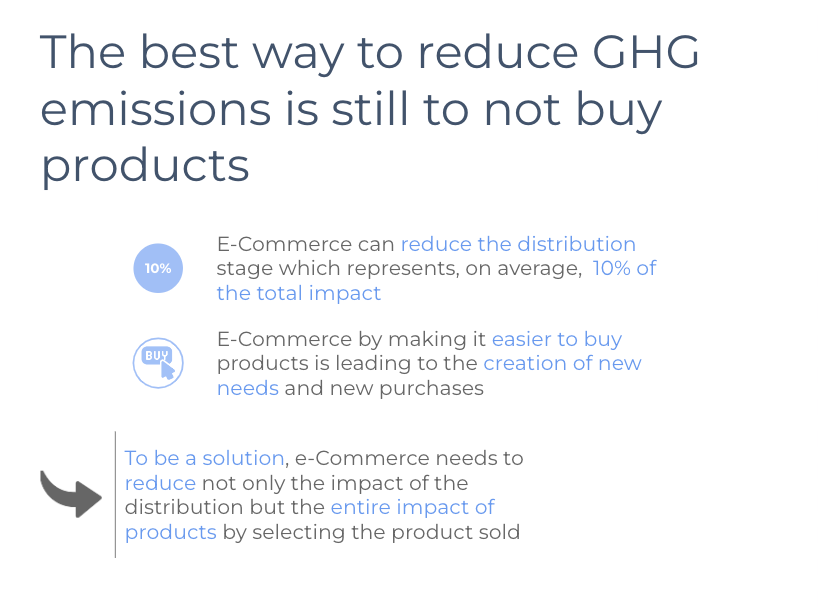
This is why e-commerce is often seen as the antithesis of sustainability because it has, most of the time, not replaced a usage but created new ones. This is why e-commerce, beyond the distribution stage, must put a lot of effort into giving the consumer information about the environmental impact of the products and also promote low-carbon ones.
If you want to discover more about Future of Commerce solutions, please reach out to us.
Sources
- https://librairie.ademe.fr/dechets-economie-circulaire/1189-modelisation-et-evaluation-des-impacts-environnementaux-de-produits-de-consommation-et-biens-d-equipement.html
- https://base-empreinte.ademe.fr/donnees/jeu-donnees
- Paul Hawken, The Ecology of Commerce, 1993
- https://www.oliverwyman.com/our-expertise/insights/2021/apr/is-e-commerce-good-for-europe.html
Glossary
* ADEME: French Environment and Energy Management Agency
Our Podcast #RebootBusiness by Julien Devaureix explores these topics.
We hope to engage in meaningful conversations with the Leaders & Pioneers who will dare to further advance their Transition and get into this next stage of Transformation.
Stay tuned, and follow us on our LinkedIn page to stay informed.
Impact Labs CSRD Offer
We are happy to introduce our tailored CSRD service offer, designed to simplify compliance with the new regulations and drive impactful sustainability strategies. This way, teams can focus on reducing their footprint and developing effective nature strategies.
We streamline the CSRD reporting process with relevant tech and tools to make it as smooth and efficient as possible. Our service is designed to guide you through every step of this transformative journey.
Checklist on 10 key aspects to consider when selecting a CSRD Tool
Selecting the right technology for implementing the Corporate Sustainability Reporting Directive (CSRD) involves several key considerations to ensure compliance, efficiency, and effectiveness.
#REBOOT Business 12 – Une Economie Plus Juste
EPISODE SUMMARYAu fil des podcasts Reboot se dessine une ligne convergente vers l’urgence impérieuse de changer le système dans sa globalité. C’est...





